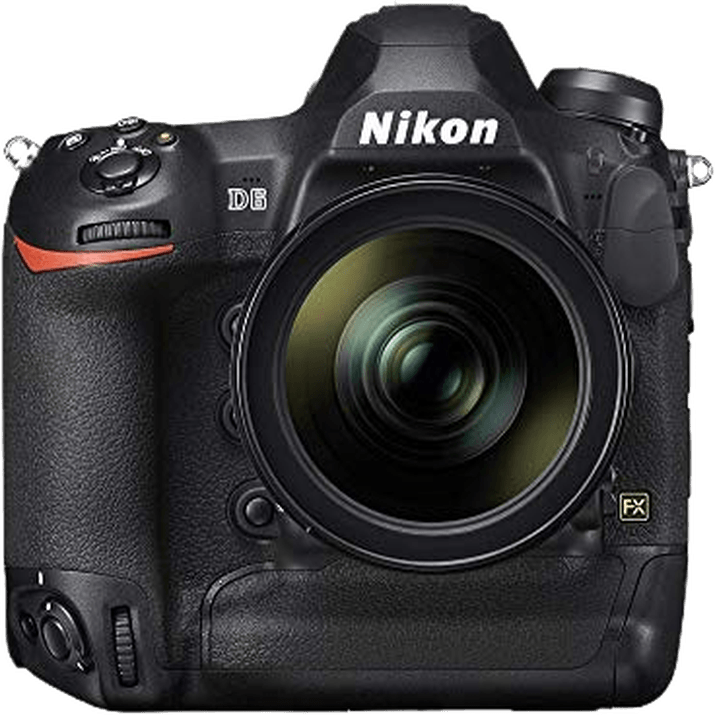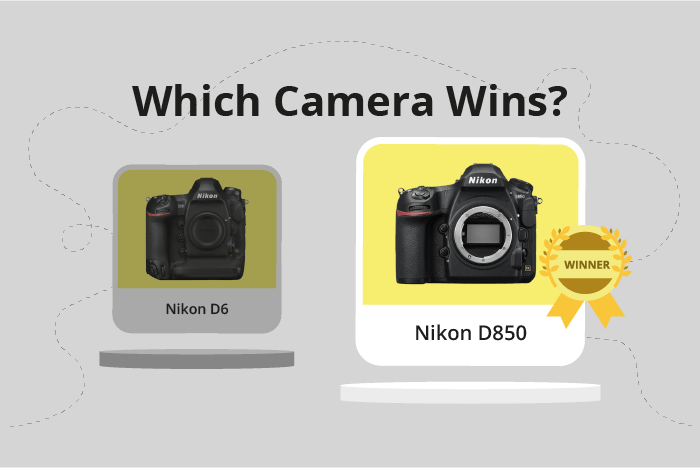Nikon D6 vs D850 Comparison
Nikon D6

Nikon D850

The Nikon D850 outperforms the Nikon D6 by a slight margin, scoring 82/100 compared to the D6’s 80/100. Both cameras are DSLR models, released in 2017 and 2020 respectively. They share similarities in design and features, such as camera type and size. However, the D850 has a smaller and lighter body, measuring 146 x 124 x 79mm and weighing 1005g, while the D6 measures 160 x 163 x 92mm and weighs 1450g.
The D850’s advantage lies in its higher score and lower launch price of $3300, compared to the D6’s $6500 price tag. On the other hand, the D6’s edge comes from its more recent release, offering the latest technology. Despite their differences, both cameras provide excellent performance and cater to different user preferences and budgets. Ultimately, the choice between the Nikon D850 and D6 depends on individual needs and priorities.
Nikon D6 vs D850 Overview and Optics
The Nikon D850 outperforms the Nikon D6 in optics with a score of 79/100, a 4-point difference from the D6’s score of 75/100. Both cameras share common specifications such as a CMOS sensor, full-frame sensor size, Nikon F lens mount, and no image stabilization.
The D850 excels with its higher megapixel count of 45.7, compared to the D6’s 20.8 megapixels. This allows the D850 to capture more detail, making it ideal for landscape, portrait, and commercial photography. Additionally, the D850 has a higher DXOMARK sensor score of 100, indicating better overall image quality, dynamic range, and low-light performance.
On the other hand, the Nikon D6 has a faster shooting speed of 14 frames per second, double the D850’s 7 frames per second. This makes the D6 more suitable for action and sports photography, where capturing fast-moving subjects is crucial. The D6 also benefits from a more advanced Expeed 6 processor, providing faster image processing and improved performance.
While the D850 offers superior image quality and resolution, the D6 is better suited for fast-paced photography, thanks to its quicker shooting speed. Both cameras have their strengths and are designed for specific photography needs. The Nikon D850 is the better choice for photographers who prioritize image quality, while the Nikon D6 is ideal for those who require speed and performance.
Nikon D6 vs D850 Video Performance
The Nikon D6 triumphs over the Nikon D850 in video capabilities, boasting a higher video score of 83/100 compared to the D850’s 70/100. Both cameras share some common specifications, such as a maximum video resolution of 4K and dimensions of 3840 x 2160. Additionally, both cameras have built-in time-lapse functionality.
The Nikon D6 outperforms the D850 in video capabilities primarily due to its superior maximum video frame rate of 60fps, compared to the D850’s 30fps. This higher frame rate enables the D6 to produce smoother and more detailed videos, particularly when capturing fast-moving subjects or scenes. This advantage makes the D6 more suitable for professional videographers and serious enthusiasts who demand top-notch video quality and performance.
On the other hand, the Nikon D850 falls short in the video frame rate department but still offers excellent video quality with its 4K resolution and time-lapse functionality. These features make the D850 a solid choice for photographers who occasionally shoot videos and do not require the higher frame rate provided by the D6.
Considering the 13-point difference in video scores, the Nikon D6 is the clear winner in terms of video capabilities. Its higher frame rate makes it the better option for those who prioritize video performance. However, the Nikon D850 remains a viable choice for photographers who do not require the highest frame rate but still want to capture high-quality videos alongside their still images.
Nikon D6 vs D850 Features and Benefits
The Nikon D6 and Nikon D850 both achieve a feature score of 87 out of 100, making them equally impressive in terms of features. They share several specifications, including a 3.2-inch screen size, screen resolution of 2,359,000 dots, touchscreen capability, Wi-Fi, and Bluetooth connectivity. Despite their identical scores, each camera has its own advantages and drawbacks.
The Nikon D6 outperforms the D850 with its GPS functionality, enabling photographers to geotag their images and track their shooting locations. This feature makes the D6 a more versatile and user-friendly option.
On the other hand, the Nikon D850 does not offer any advantages over the D6 in terms of features, as they share the same specifications in all other aspects. However, it is important to note that the D850 is not inferior to the D6.
Considering these factors, the Nikon D6 emerges as the better option for photographers seeking a camera with more versatile features. The flip screen and GPS functionality provide added convenience and flexibility during photo shoots. While the Nikon D850 matches the D6 in most specifications, it falls short in these two areas. Ultimately, the choice between the two cameras will depend on the individual photographer’s needs and preferences, but the Nikon D6 offers a slight edge in terms of features.
Nikon D6 vs D850 Storage and Battery
The Nikon D6 outperforms the Nikon D850 in storage and battery, scoring 100/100 compared to the D850’s 84/100. Both cameras share some common specifications, including two memory card slots and compatibility with XQD memory cards. The D6, however, accepts CFexpress cards, while the D850 is compatible with SD/SDHC/SDXC (UHS-II) cards.
The winning Nikon D6 boasts a superior battery life of 3580 shots, using the EN-EL18c battery type, and provides the convenience of USB charging. On the other hand, the Nikon D850’s battery life is significantly lower at 1840 shots, utilizing the EN-EL15a battery type, and lacks USB charging capabilities.
Considering these factors, the Nikon D6 is the clear winner in storage and battery performance, offering greater battery life and more advanced memory card compatibility. Despite its lower score, the Nikon D850 still provides a decent battery life and versatile memory card options, making it a suitable choice for photographers with less demanding storage and battery requirements.
Alternatives to the Nikon D6 and D850
Are you still undecided about which camera is right for you? Have a look at these popular comparisons that feature the Nikon D6 or the Nikon D850:

